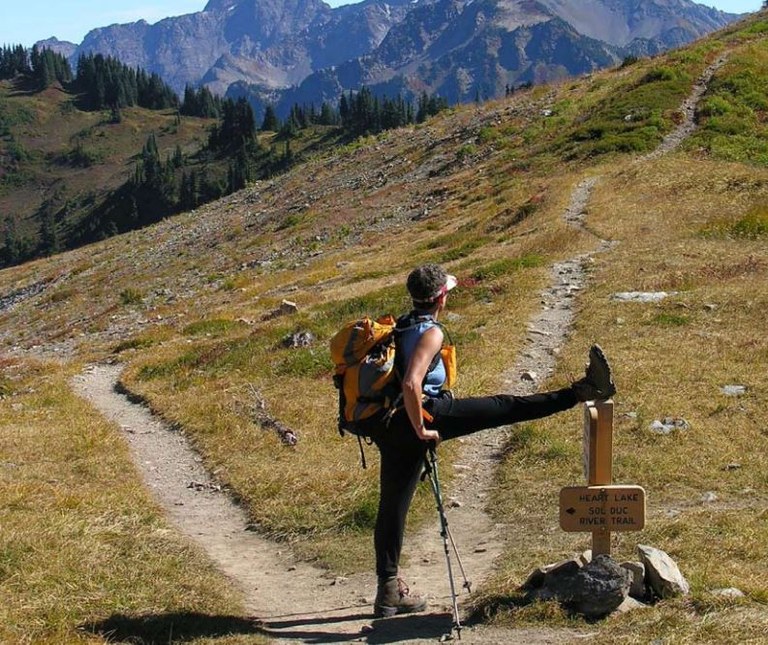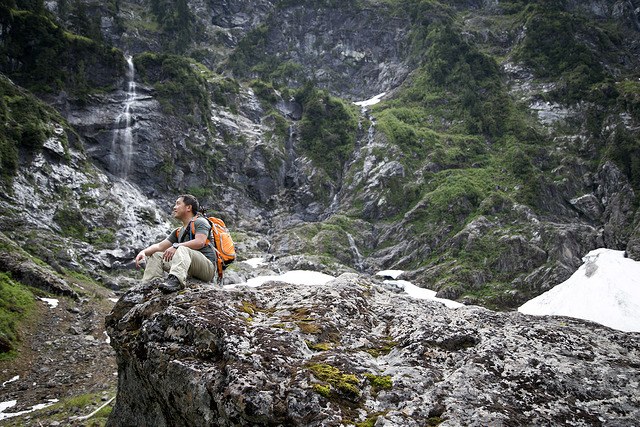 Washington Trails
Association
Washington Trails
Association
Trails for everyone, forever
Imagine yourself high on an alpine ridge. Wildflowers wave in the breeze as you sprawl on a granite slab, taking in the surrounding peaks. Now imagine the hike to all this was also enjoyable -- maybe even fairly easy. If this is the scenario you’d like to experience this hiking season, now is the time to start your conditioning | by Pam Roy

Hiker Sherri Cassutto takes a stretching break on the High Divide Trail in the Olympics.
By working on your strength, endurance, flexibility and balance, you’ll make your time on trail more enjoyable.
Most trainers suggest an eight- to twelve-week training program to get in shape. The good news is that you don’t have to spend the next three months in the gym. The best way to prepare yourself to hike is by going hiking.
By engaging in regular aerobic activity and spending a couple of short sessions per week focusing on strength and flexibility, you’ll be able to hike your way into optimal fitness. But supplementing with strength training is a good idea, too.
Decide what your goal is. What distance and elevation gain do you want to be able to complete in a day? Then build a training program that has you reaching 80 to 90 percent of that goal a couple of weeks before the hike. Here's a sample training program.
Regular aerobic activity is important to increase your cardiovascular capabilities. This gives you the ability to reach those scenic vistas with less huffing and puffing. Hiking is a lower-intensity activity, meaning the ability to keep a steady pace is more important than sprinting, so optimal cardiovascular training will be at 60 to 80 percent of your maximum heart rate.
 Going for a jog on the Lake Eleanor Trail. Photo by Kevin Kincaid.
Going for a jog on the Lake Eleanor Trail. Photo by Kevin Kincaid.A heart rate monitor can be worn while exercising to keep you working at an intensity that’s difficult enough to be beneficial. Many cell phones and watches have apps or features that will help monitor your heart rate while you're on trail.
Use cardio training to slowly build an aerobic base. Activities that use the same muscles as hiking can help prepare you for time on the trail. Running, walking fast, or climbing stairs are good options. Or, consider indoor exercises like elliptical trainers, Stairmaster or stationary bike.
Cross-training with low-impact activities such as biking, swimming, and inline skating reduces the risk of injuries, and adds variety and freshness to your workouts. A day of swimming gives you a chance to recover from hiking uphill the day before. Start and end each session with a short warm-up and cool-down: take a brisk five-minute walk before and after a run, for instance.
Begin with a duration and intensity that reflects your current level of fitness (be honest here). During the week, plan three days of thirty- to sixty-minute walks. Increase the benefit of these walks by choosing routes off pavement, and include hills and rolling, uneven terrain.
Training frequency: 3-5 days per week of at least 30-60 minutes of cardiovascular focus for general health.
Traversing scree slopes, inching across slippery logs and carrying a pack all require more than just strong lungs and legs. Building core strength (in your stomach, hips, pelvis, back and upper body) will make hiking more enjoyable, minimize sore shoulders and back, increase your control and prevent injuries.
 Young hikers can also benefit from strength training. Photo by Lorelei Felchlin.
Young hikers can also benefit from strength training. Photo by Lorelei Felchlin.
Build leg, core, and arm strength with strength training. Extra credit: As you gain strength, do the leg and upper body exercises wearing a pack.
Use WTA's Hiking Guide to find a trail network near you. Vary the route to keep things interesting, and walk with a friend, who will help you stick to your training program. Wear a pack on at least two of these walks each week. Start out light (around 10 pounds) and build up gradually over the 12-week period. Use water bottles or a hydration bladder for weight. Add other gear as you develop strength, increasing weight by 3 to 5 pounds per week, working toward the weight you plan to carry overnight.
On weekends, plan a longer hike and carry your pack. Build gradually up to the distance and elevation gain you want to be able to hike. Add no more than 10 to 20 percent to your distance and elevation gain per week.
Once you’ve established an aerobic base, add tempo training to help those uphill sections of trail melt away. Find some hills or stairs.

Better yet, find some stairs with views of the hills. Photo by Alistair.
Hike uphill moderately fast, at a tempo where you cannot quite carry on a conversation and maintain that pace for thirty to sixty seconds initially. Slow down until your heart rate drops and your breathing returns to near normal. Repeat until you can do five of these. Increase over several weeks to two to three minutes of fast tempos. Ease up on the downhills to avoid over-stressing joints.
Hikers should stretch at least three times per week, and after strenuous hikes. Hold each stretch thirty seconds and repeat two times. Yoga promotes flexibility and can also be very beneficial to the hiker. Carrying a heavy pack tends to compress the spine.

Yoga postures like the Sun Salutation and Downward-Facing Dog can help decompress the spine. Yoga instructor Roy Holman recommends simply folding forward from the waist and letting arms hang down as a great stretch for the back after carrying a pack.
(Into yoga? Check out Nicole Tsong's Yoga for Hikers from Mountaineers Books.)
To help navigate that knife-edged ridge, or leap from boulder to boulder in a river crossing wearing a pack, spend some time improving your balance.
One simple exercise to improve balance is to stand on one foot. Simply lift up one leg and maintain balance. This is easy to do even in the office, if you have a standing desk, or while you are making a meal in the kitchen.
To increase challenge, close your eyes. For fun, stand on one foot and toss a ball back and forth with your hiking buddy who’s also standing on one foot.
Rest is an important part of any training program. Give yourself two rest days a week initially, then taper to one rest day. This avoids overtraining and burnout. Your muscles need time to repair themselves.
Once a month, have one week where you do not increase any of the distances or elevations and use this as a recovery week.

It's important to balance training with low-key hikes. Stop and enjoy your surroundings. Photo by Tuck Tongpattanakul.
Overtraining is one of the most common reasons people ditch their training programs or peak too early in the process. If you’ve been ill or injured or haven’t been exercising regularly, it’s important to consult your doctor before starting any conditioning program. The most important part is to keep it fun.